If you’re looking for an automatic cannabis trimmer, here is what you need to know to find the best solution for your needs.
Cannabis trimmers can reduce labor costs by 99% while doing as good of a job as your best hand trimmers. It’s true: machine trimming doesn’t chew up your flowers like the legacy trimmers from the early days of cannabis processing. In addition, modern bud trimmers are fast and efficient.
While these newer types of cannabis trimmers are efficient and accurate, not every trimmer will be best suited for your specific needs. Get tips to help you find the best cannabis trimmer for your production.
How to Choose the Best Bud Trimmer Machine
As you check out your options, it’s worth thinking carefully about how you approach various aspects of post-processing, such as:
Wet vs. Dry Trimming
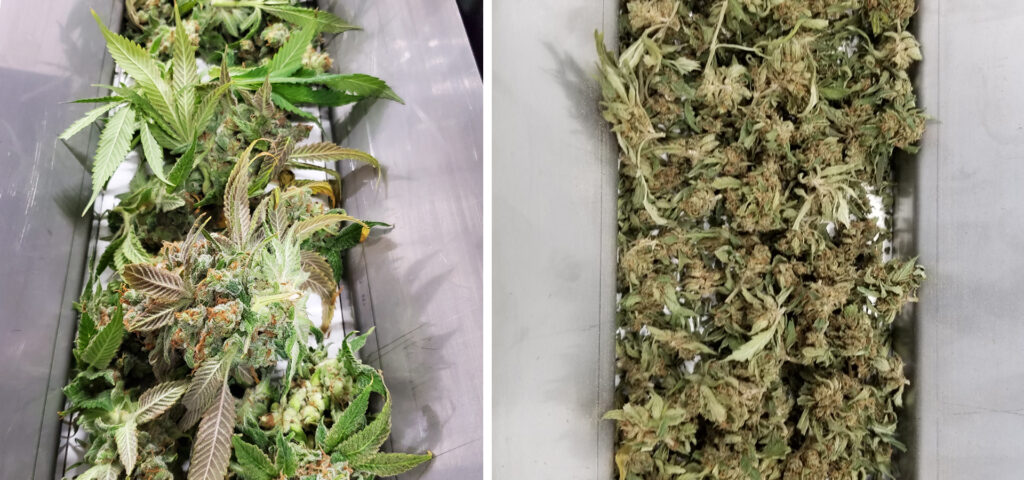
Before determining the best bud trimmer for your operations, you’ll need to decide if you plan on processing your flower wet or dry.
For wet trimming processes, cultivators may consider a hybrid bud trimming machine that can process varying moisture levels and is suitable for both wet and dry applications. Depending on your facility design, staffing availability, desired end product, and harvest volume, a hybrid trimmer could be a good solution for your operation.
When harvesting large quantities of flower, it may make sense to get the trimming done immediately and dry the flowers afterward. The wet trimming method is popular with large-scale growers and those who value efficiency.
If you hang your plants for drying on harvest day, the best automatic bud trimmer for you will be a dry trimming machine. This is a cannabis trimmer designed for gently trimming dry buds, to preserve your delicate and dried trichomes. Drying before you trim increases the quality of your final product. There are specific requirements for a dry trim process that need to be considered to ensure you get the best results.
Intended Products
Another factor to consider is your desired end product. Your processing method will change based on what your intended goals are for your final products. For example, if you’re using your flowers to create extracts, wet trimming can give you a tighter trim. When creating premium flower for smoking, dry trimming is preferred because of the slow drying process and reduced chlorophyll content.
Harvest Volume
Of course, you want to buy a bud trimmer machine that matches your production capacity. Make sure to anticipate your growth when you make your purchase—you don’t want to outgrow your new automatic trimmer immediately. It’s better to buy one that’s a little too big, yet not way oversized.
Look for a trimming machine that suits your current output but can also adapt to your needs in the years ahead. Remember, some trimming machines can be run in tandem so that you can buy another later for maximized efficiency.
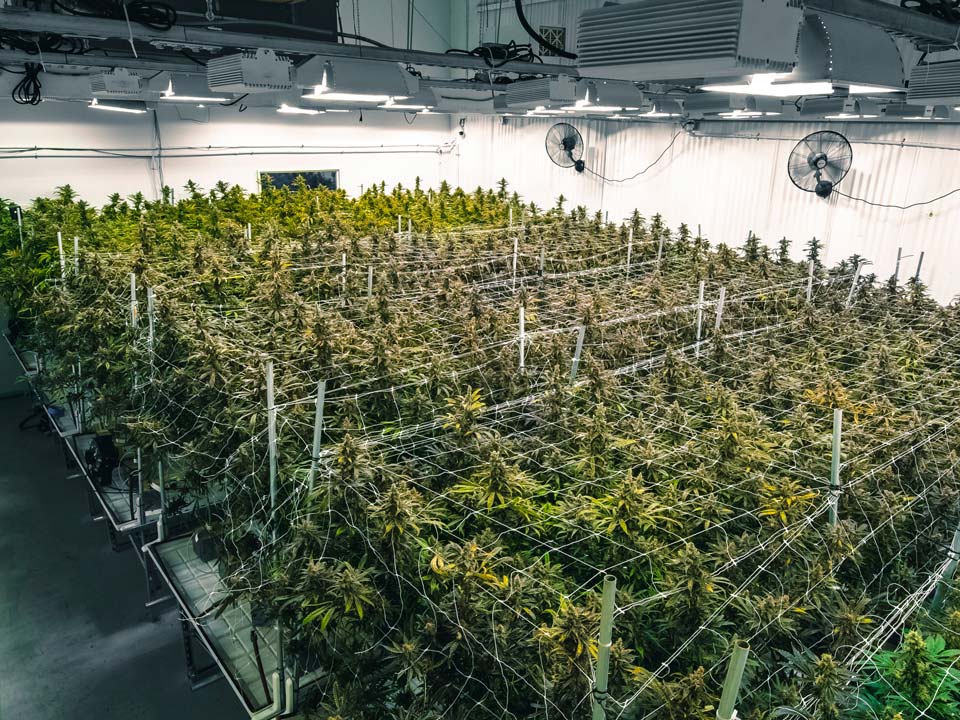
Operations and Workflow
Facility design and staff availability is another factor to consider. The space available in your trim room will help determine what kind—and size—of machine trimmer would be best for your facility. For facilities with smaller available space, drying the cannabis before trimming may be impossible. In that case, a hybrid or wet trimmer would be preferable. However, for wet trimming, you may need more employees to handle the workload during harvest times. For facilities with larger available space to dry the plants, a dry trimmer can work with fewer employees and result in more potent and flavorful trimmed buds.
Types of Cannabis Trimmers
There are bud trimmers for wet trimming and dry trimming, and within those two categories, you’ll find two variants: batch trimmers and throughput trimmers.
Batch Trimmers
A batch cannabis trimmer processes one load of flower at a time, typically in batches ranging anywhere from 2 to 60 lbs. The technician puts untrimmed cannabis or hemp in the machine, sets it to run, and walks away to do other tasks like packaging or snipping crows’ feet. After a few minutes, they empty the newly trimmed bud and put in another load.
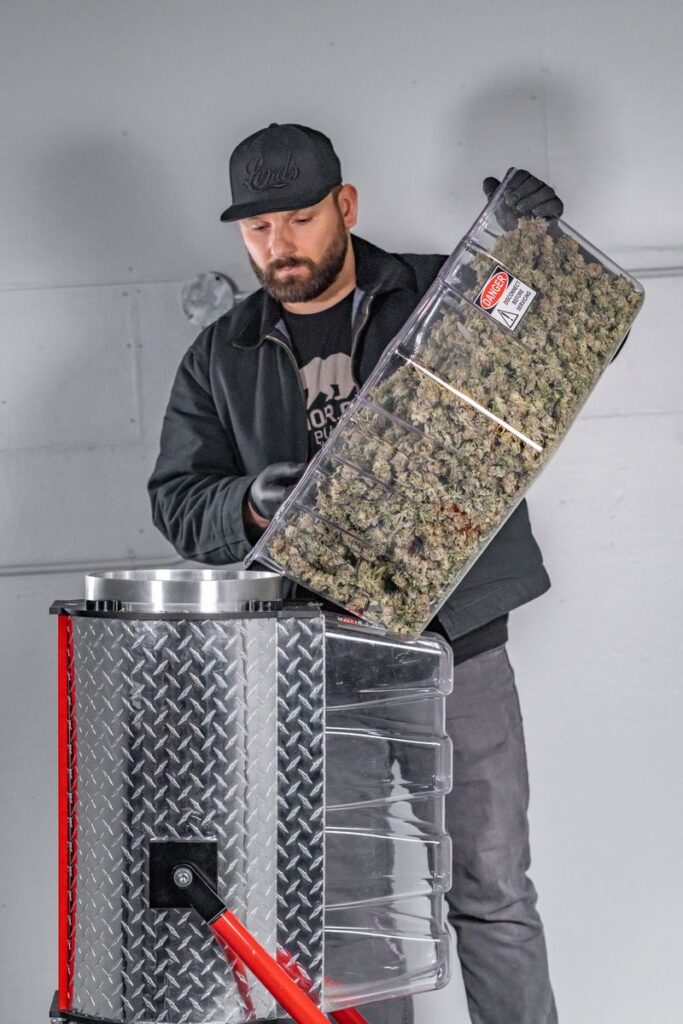
Batch trimmers are limited to trimming dry material in the 8-11% moisture range and typically omit the vacuum systems required on most throughput trimmers. The advantage of this is that they are quiet and can do higher volumes at lower price points.
The disadvantage is that they can’t be used on flowers with a moisture content beyond 11%, limiting their versatility and use in high-humidity environments.
Batch trimming works well when staff is limited or for trim-to-order operations. It only takes one person to run a batch trimmer, though you may employ multiple people to speed things up by doing the prep work, such as bucking, ahead of time.
If you want to increase your production capacity, you will need to add additional trimmers to the process. Doing so may require additional staff since they can’t be run in tandem, although one person can typically operate 2-4 individual batch trimmers. Given this, if you anticipate increased production in the future, it is more cost-effective to buy a bigger machine initially than buying multiple smaller units as you grow.
Throughput Trimmers
Throughput trimmers work like an assembly line by continuously trimming as plant material is fed into the machine. This style of trimming requires the constant attention of the operator to feed the machine. With some trimmers, you could add a conveyor to help keep the feed rate consistent and the machine’s performance optimized.
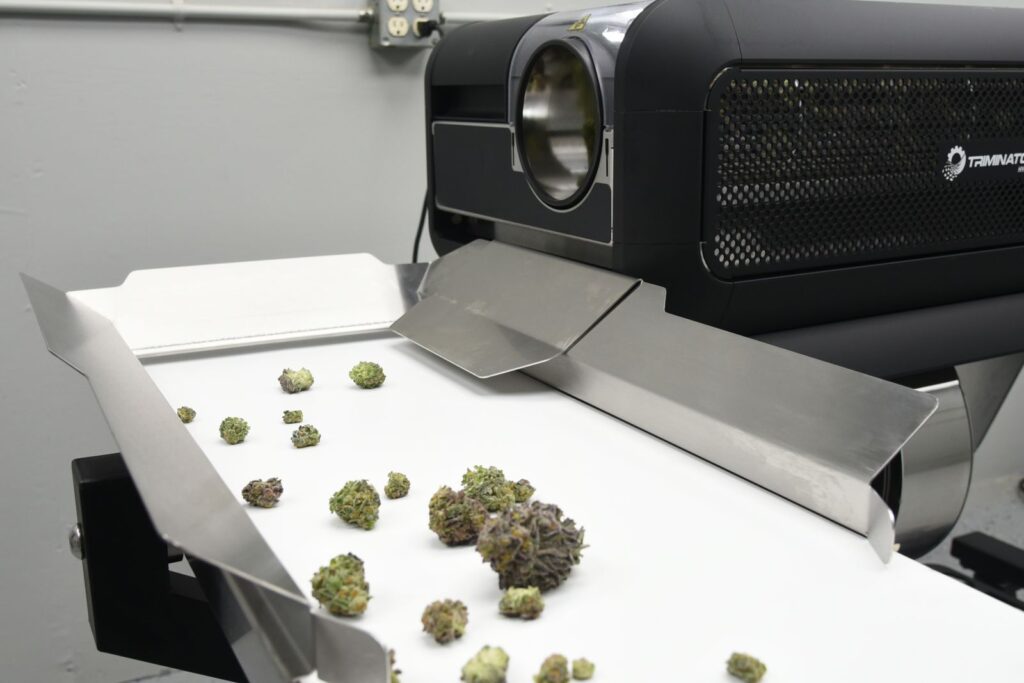
For the most efficient cannabis trimming process, you will need plenty of bucked flowers prepared to feed the trimmer. You will also need a system to ensure that the flower is being bucked faster than it is being trimmed.
Throughput trimmers have an advantage over batch-style trimmers in that they can trim both wet or dry flowers at a wide range of moisture levels. This means the same machine can be used for wet outdoor harvests or boutique dry indoor crops.
It is important to review the capabilities of the throughput machine. You want to ensure it has been designed for wet and dry trimming. Many throughput trimmers are simply retrofitted wet trimmers and do not have the controls to trim dry without incurring significant trichome losses. These losses are caused by high-powered vacuum units sucking the delicate trichomes from the flowers and into the blades.
Throughput trimming can be scaled efficiently by adding additional units to the original. This allows you to more than double production while reducing labor costs due to assembly line efficiencies.
This means that you can purchase a small throughput trimming machine at lower production levels. Then, you can add additional units as your production levels increase without dramatically increasing your labor requirements.
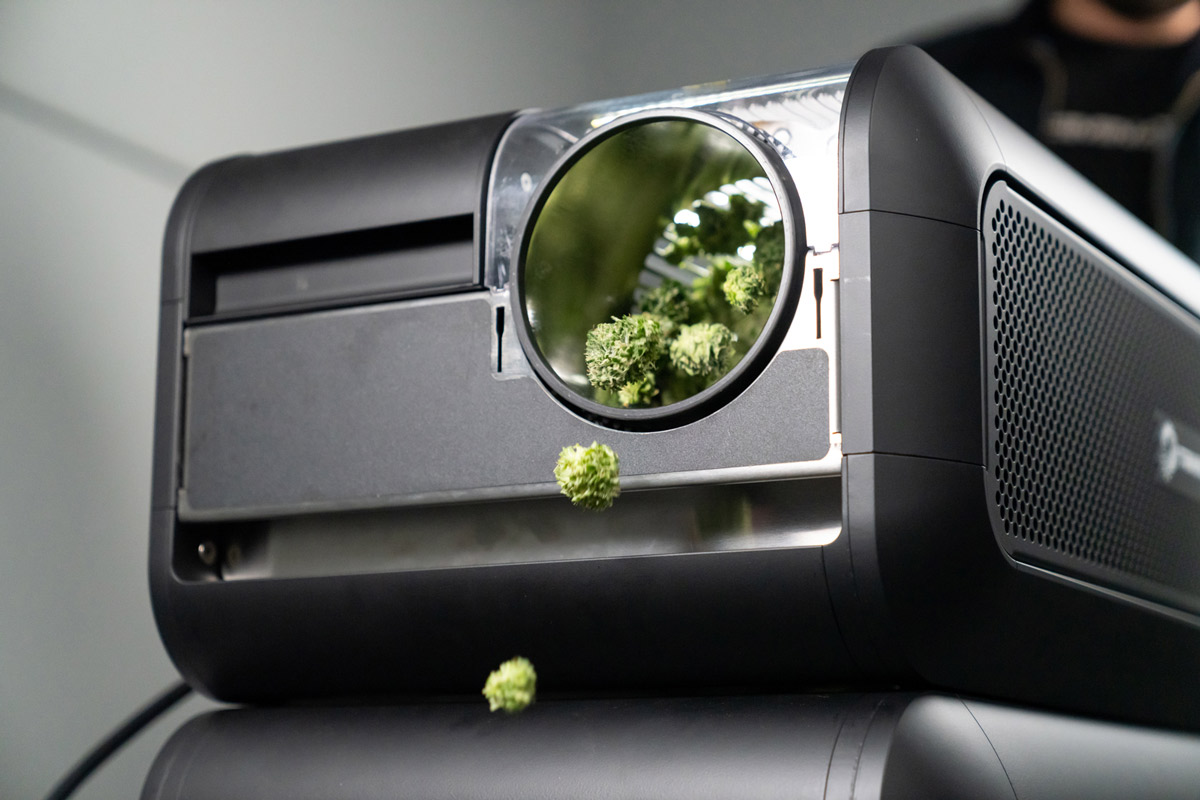
Connect with a trimming expert today.
Industry-Leading Batch-Style Trimmers
The Triminator Dry is an innovative professional batch bud trimmer capable of processing up to 20 lbs of flower per hour.
To run the trimmer, the technician tilts the tumbler vertically and loads a few pounds of dry material into it. They then rotate the tumbler horizontally and run the machine for 3-5 minutes until they get the perfect trim. The time in the electric bud trimmer will vary based on the strain, shape of the flowers, and desired level of trim.
The trimming machine has a proprietary food-grade polymer “shear band” that prevents resin build-up. Unlike a metal-on-metal blade system, the proprietary polymer band creates very little friction, keeping the cutting surface cool and minimizing trichome loss.
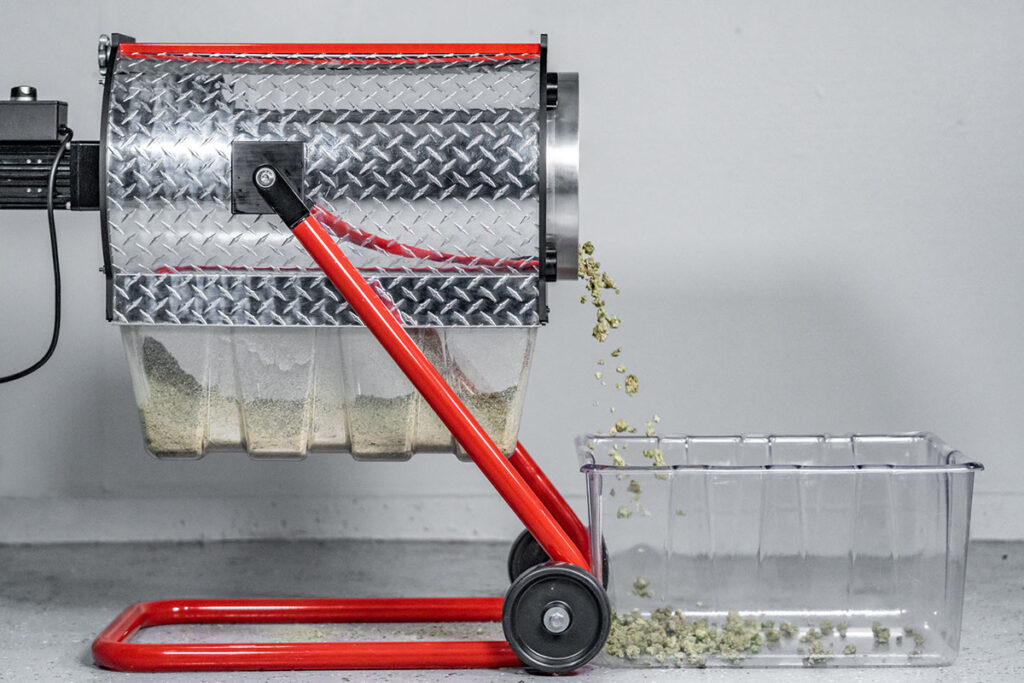
The Triminator Dry trimmers also have an optional kief tumbler. By switching out the trimming tumbler for the kief tumbler, you can maximize the value of your harvest by converting your trim to kief. This allows cultivators to cost-effectively generate multiple revenue streams from their flowers using a single dry trimming machine. For those growers working at different scales, Triminator offers the Mini Dry trimmer, which gives the same results at smaller quantities and a lower price point, and the Triminator XL, which offers commercial production capacity and speeds.
An Innovative Throughput Hybrid Trimmer
When looking into options for throughput trimmers, you’ll want something that can deliver hand-trimmed quality flower regardless of the moisture content.
The Hybrid™ is designed for speeds up to 40 pounds per hour with one unit, and easy operation. The Hybrid’s throughput more than doubles with 2 units in tandem, allowing for scalable production. Like other throughput trimmers, it uses a continuous feed tumbler. The difference—and what makes it faster and more precise than other trimmers—is the revolutionary Flex-Knife™. It works by pressing against the helical blade, keeping the surfaces in constant contact for an ultra-clean cut and scissor-like result.
In addition, to accommodate the variable moisture levels of dry trim, semi-dry, and wet trim processes without trichome loss, the Hybrid™ has variable speed controls that allow you to customize your trim with the touch of a button.
Ready to Invest in a Trimmer?
To choose the best cannabis trimmer, you’ve got to talk to the experts. Connect with a harvest specialist to discuss types of trimmers and what will be best for your facility and needs.